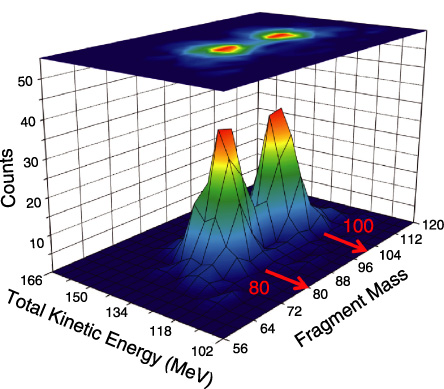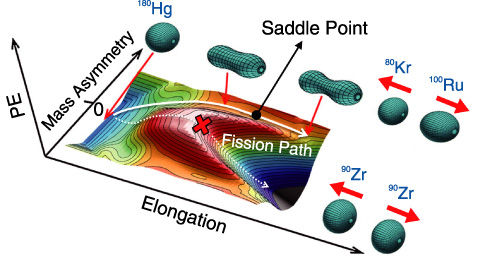
Fig.6-7 Fission properties of 180Hg

Fig.6-8 Fission path of 180Hg
When the phenomenon of nuclear fission was discovered, a nucleus was modeled to be a liquid drop with a charge and fission was considered to occur when a nucleus overcomes the fission barrier (saddle point). This classical model, however, cannot explain some features such as mass asymmetry in the neutron-induced fission of 235U. Therefore, the effects of the energy levels of the protons and neutrons in a nucleus were taken into account. A nucleus with a closed-shell structure has high binding energy and thus a low mass (energy). The fission proceeds in such a manner that nuclei with closed-shell structures are preferentially formed to have the smallest energy at the end of nuclear rupture. In the neutron-induced fission of 235U, one fragment is preferentially formed in the vicinity of 132Sn, which has the closed proton and neutron shells. The other is the complementary fragment. The effects of the 132Sn nucleus on fission have been observed in the fissions of the actinide nuclei.
In this study, our aim was to see if the present fission model can explain the fission of nuclei that are more unstable than 235U. We chose 180Hg as the proton-rich nucleus and for the first time, conducted an experiment to study the fission properties in such a light-nucleus region. According to the present knowledge, two 90Zr isotopes should be produced because 90Zr has a closed neutron shell. The experimental result, however, revealed that the most dominant masses were 80 and 100, as shown in Fig.6-7, which suggested the production of 80Kr and 100Ru. The yield of 90Zr was significantly small. 180Hg underwent the new type of fission, and it was not regulated by shells of the fragments.
Fig.6-8 shows the potential energy of 180Hg, calculated for the first time as a light element to understand how the fission proceeds on the nuclear-shape. Because of the high fission barrier at the mass-symmetry, the symmetric fission fragments 90Zr are not produced (dotted curve in Fig.6-8). On the other hand, in the case of mass asymmetry, the saddle point appears at a low barrier height, which can be easily overcome to yield mass-asymmetric fission fragments (solid curve in Fig.6-8).
Fission of unstable nuclei provides information about the level structures of the protons and neutrons for the extremely elongated nuclear shape. Understanding the structure will help improve the fission model for evaluating nuclear data and studying the reaction between heavy ions.